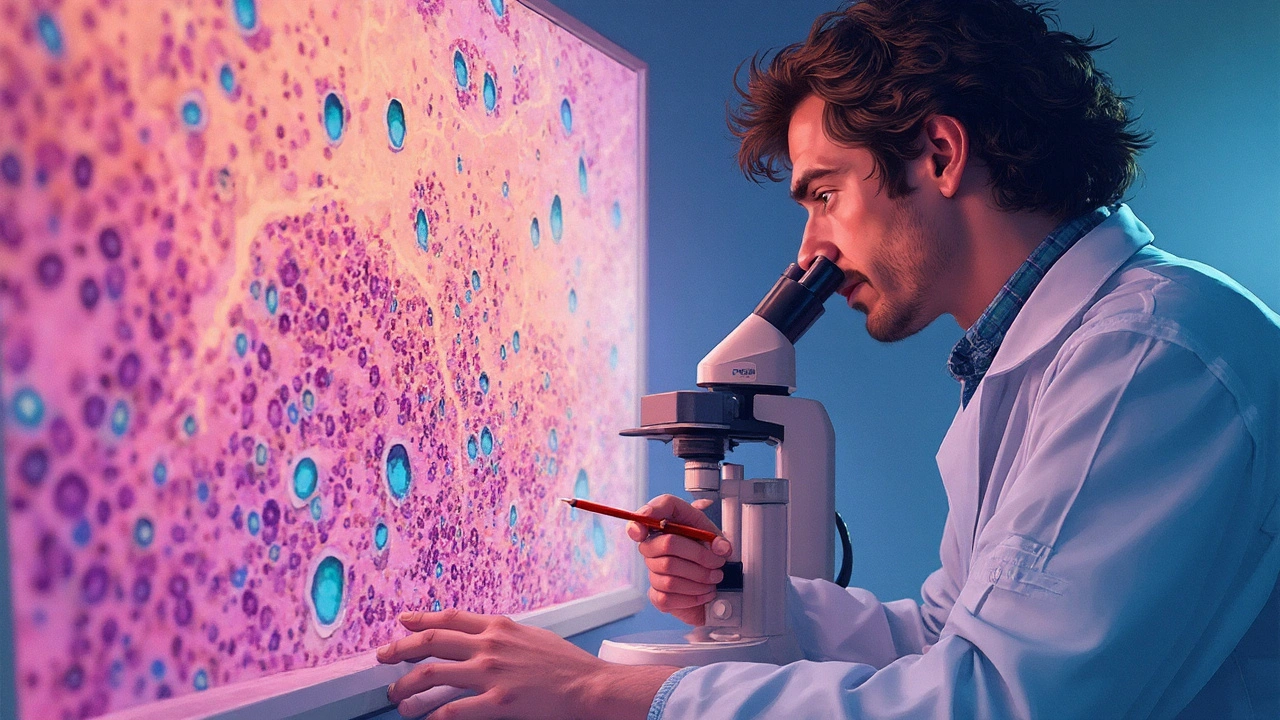Mycosis Fungoides is a rare, slow‑growing cutaneous T‑cell lymphoma that starts as reddish patches or plaques on the skin. It accounts for about half of all primary skin lymphomas, but many people never hear the name until a dermatologist spots the characteristic lesions. This article answers the questions patients, families and clinicians ask most often, from what triggers the disease to how the latest therapies improve survival.
Understanding Mycosis Fungoides
Mycosis Fungoides belongs to the broader group of Cutaneous T‑cell Lymphoma (CTCL). Unlike systemic lymphomas that start in lymph nodes or bone marrow, CTCL originates from malignant T‑cells that home to the skin. The disease follows a predictable pattern: patches → plaques → tumors. Early stages may look like eczema or psoriasis, which is why skin biopsies are essential for a definitive diagnosis.
What Triggers Mycosis Fungoides?
The exact cause remains unknown, but several risk factors have emerged from epidemiological studies:
- Age: most patients are diagnosed after 55 years.
- Gender: men are slightly more affected than women.
- Chronic immune stimulation: long‑standing eczema, infections or exposure to certain chemicals (e.g., pesticides) appear to increase risk.
- Genetic mutations: alterations in genes like STAT3and TP53 are found in biopsy samples.
These clues help clinicians counsel patients about lifestyle factors, but there is no proven way to prevent the disease.
Typical Symptoms and How to Spot Them
Early lesions are often mistaken for benign skin problems. Key warning signs include:
- Persistent, scaly patches that do not respond to steroids.
- Itching (pruritus) that worsens at night.
- Color change: lesions may be pink, reddish‑brown or even darker than surrounding skin.
- Location: trunk and limbs are common, but any body area can be affected.
When patches evolve into raised plaques or nodules, the risk of progression to tumor‑stage disease rises sharply.
Diagnosing Mycosis Fungoides
Diagnosis hinges on skin biopsy and specialized laboratory tests. The process generally follows these steps:
- Histopathology: pathologists look for atypical lymphocytes with cerebriform nuclei infiltrating the epidermis (Pautrier microabscesses).
- Immunophenotyping: flow cytometry confirms the T‑cell markers CD3+, CD4+, and loss of CD7, a hallmark of MF.
- T‑cell receptor (TCR) gene sequencing: demonstrates clonality, proving the cells are malignant.
- Staging work‑up: blood tests, imaging (CT or PET) and, if needed, lymph node biopsy to assess spread.
Because early disease can mimic eczema, a second biopsy is sometimes required if initial results are inconclusive.
Staging Mycosis Fungoides
The Staging System (TNM‑based classification used by the WHO‑EORTC) divides MF into four main categories (IA‑IV), each reflecting skin involvement, lymph node status, blood involvement and visceral disease.
| Stage | Skin | Lymph Nodes | Blood | Prognosis |
|---|---|---|---|---|
| IA | Limited patches/plaques covering <10% BSA | None | Negative | 5‑year survival >95% |
| IB | Extensive patches/plaques covering ≥10% BSA | None | Negative | 5‑year survival ~90% |
| IIA | Patch/plaque disease with early lymph node involvement | Limited | Negative | 5‑year survival ~80% |
| IIB | Skin tumors present | Variable | May be positive | 5‑year survival 50‑70% |
| III | Generalized erythroderma | Often involved | Positive (Sezary cells) | 5‑year survival 30‑50% |
| IV | Visceral organ involvement | Widespread | Positive | 5‑year survival <20% |
Understanding the stage guides treatment choice and helps patients set realistic expectations.

Treatment Options Across the Spectrum
Treatment is tailored to the stage, symptom burden and patient comorbidities. Broadly, therapies fall into skin‑directed and systemic categories.
Skin‑Directed Therapies
For early‑stage disease, the goal is to control skin lesions while preserving quality of life.
- Phototherapy (UV‑based treatment using UVB or UVA with psoralen) is effective for patches and plaques. Typical regimens use 2‑3 sessions per week for 12‑24 weeks, achieving remission in 60‑80% of patients.
- PUVA therapy (psoralen + UVA, a stronger form of phototherapy) is reserved for thicker plaques or when narrow‑band UVB fails.
- Topical steroids, retinoids (e.g., bexarotene) and nitrogen mustard are used as adjuncts, especially for localized lesions.
Side effects include skin aging and, rarely, secondary skin cancers, so dermatologists monitor cumulative UV exposure.
Systemic Therapies
When disease progresses to tumor stage or involves blood/lymph nodes, systemic options become necessary.
- Brentuximab vedotin (CD30‑targeted antibody‑drug conjugate) shows high response rates in CD30‑positive MF, with median progression‑free survival of 13 months in recent trials.
- Vorinostat (HDAC inhibitor approved for CTCL refractory to skin‑directed therapy) yields overall response rates of 30‑35% and is taken orally, making it convenient for long‑term use.
- Bevacizumab, interferon‑alpha, and low‑dose methotrexate are older options still employed in certain regimens.
Combination approaches-e.g., PUVA plus interferon‑alpha-are common in academic centers, aiming to synergize skin‑directed and immune‑modulating effects.
Advanced Disease and Emerging Therapies
StageIII/IV patients often require newer agents:
- Immune checkpoint inhibitors (e.g., pembrolizumab) are being trialed, leveraging the tumor’s high mutational burden.
- CAR‑T cell therapy targeting CD30 is in early phase studies, showing promise for refractory cases.
- Allogeneic stem cell transplant remains the only potentially curative option, but eligibility is limited by age and organ function.
Is Mycosis Fungoides the Same as Sézary Syndrome?
Both belong to CTCL, but there are key differences. Sézary syndrome (leukemic variant of CTCL characterized by circulating malignant T‑cells) presents with generalized erythroderma, lymphadenopathy and a high count of Sézary cells in blood. Compared with classic MF, Sézary syndrome has a poorer prognosis and often requires systemic therapy from the outset.
| Feature | Mycosis Fungoides | Sézary Syndrome |
|---|---|---|
| Blood Involvement | Usually negative | Positive (Sézary cells) |
| Skin Presentation | Patch → plaque → tumor | Generalized erythroderma |
| Typical Stage at Diagnosis | IA‑IIA | III‑IV |
| First‑line Therapy | Phototherapy, topical agents | Systemic agents (e.g., HDAC inhibitors) |
| 5‑Year Survival | >90% | ≈30‑50% |
Understanding the distinction helps clinicians pick the right treatment intensity early.
Living with Mycosis Fungoides
Beyond medical care, day‑to‑day management matters:
- Skin care: fragrance‑free moisturizers reduce itching and barrier disruption.
- Sun protection: while UV therapy is therapeutic, unprotected sun can worsen lesions or trigger new ones.
- Psychological support: chronic skin disease carries a high risk of anxiety and depression; counseling or support groups are advisable.
- Follow‑up schedule: dermatology visits every 3-6months in early stages, more frequent if systemic therapy is used.
Patients who stay active, maintain a healthy weight and avoid smoking tend to tolerate therapies better and have fewer complications.
Related Topics Worth Exploring
If you found this guide helpful, you might also want to read about:
- “Cutaneous T‑cell Lymphoma: An Overview” - a broader look at all CTCL subtypes.
- “Advances in HDAC Inhibitors for Skin Lymphomas” - deep dive on drugs like vorinostat and romidepsin.
- “Managing Pruritus in Lymphoma Patients” - practical tips for the persistent itching that many MF patients experience.
Frequently Asked Questions
What is the typical age of diagnosis for Mycosis Fungoides?
Most people are diagnosed after the age of 55, with a median age around 60. Younger patients can develop the disease, but they represent less than 10% of all cases.
Can Mycosis Fungoides be cured?
Early‑stage MF is often controllable for decades with skin‑directed therapy, leading to near‑normal life expectancy. True cure is rare and usually limited to patients who undergo allogeneic stem‑cell transplant, which is feasible only for a small, fit subset.
How is Mycosis Fungoides different from eczema?
Eczema usually responds quickly to topical steroids and has a clear pattern of flare‑remission. MF patches persist despite steroids, often show a uniform color change, and histology reveals atypical T‑cells. A skin biopsy is the definitive way to tell them apart.
Is phototherapy safe for long‑term use?
When administered according to dermatology guidelines, phototherapy is considered safe. Cumulative UV dose is monitored to keep the risk of secondary skin cancers below 1‑2% over a decade of treatment.
What systemic drug is approved for refractory Mycosis Fungoides?
Vorinostat, an oral histone deacetylase inhibitor, received FDA approval for CTCL that has failed at least one skin‑directed therapy. It offers a convenient pill option with a response rate around 30%.
Can lifestyle changes slow disease progression?
While no lifestyle measure halts MF, maintaining a healthy weight, avoiding smoking, and protecting skin from excessive sun can improve overall health and reduce treatment‑related complications.
What is the prognosis for stage IIB disease?
Stage IIB (skin tumors) carries a 5‑year survival of roughly 50‑70%, depending on response to systemic therapy and whether blood involvement emerges.
Are clinical trials available for Mycosis Fungoides?
Yes. Ongoing trials explore checkpoint inhibitors, CAR‑T cells, and novel HDAC inhibitors. Patients can ask their oncologist or check national registries for eligibility.


Seeing how many people think mycosis fungoides is just another rash makes my blood boil. It’s a real cutaneous T‑cell lymphoma, not a harmless skin irritation. The fact that early stages can be mistaken for eczema only adds to the frustration – we need more awareness, not dismissive attitudes. Hopefully folks read the guide and stop spreading misinformation.
Hey, I totally get the confusion – it’s a tough thing to spot at first :) Stay hopeful and keep following up with your dermatologist, they’ll guide you through the biopsies and treatment options. You’re not alone in this journey, and every step forward counts.
Let’s keep the momentum going! Early‑stage MF can be managed for years with skin‑directed therapies, so staying proactive with regular check‑ups is key. Remember, every patch that doesn’t respond to steroids is a signal to get a biopsy – better safe than sorry.
Absolutely! 🌟 Keeping an eye on those persistent patches and using fragrance‑free moisturizers can really help. And don’t forget sunscreen – even though UV therapy is therapeutic, you still want to protect your skin from excess sun. Stay positive! 😄
Just keep your appointments; consistency matters.
Exactly, regular follow‑ups are essential; they allow your doctor to monitor disease progression and adjust therapy as needed. Moreover, maintaining a healthy lifestyle – balanced diet, adequate sleep, and stress reduction – can improve treatment tolerance. Keep a symptom diary, noting any new plaques or changes in itching, and bring it to each visit. This proactive approach often leads to better outcomes and a higher quality of life.
Just a heads up – the pharma giants love pushing HDAC inhibitors without fully disclosing long‑term risks. Keep an eye on the research community; sometimes the most effective treatments are hidden behind layers of corporate PR.
Honestly, it’s ridiculous how people swallow every new drug hype without demanding real data. The side‑effects of vorinostat are downplayed, and patients end up dealing with nausea, fatigue, and more. We need stricter oversight, not blind optimism.
If we view mycosis fungoides as a mirror reflecting the complexities of our immune system, it challenges our simplistic notions of disease. The skin becomes a canvas where cellular rebellion paints its story, urging us to reconsider the boundaries between health and pathology.